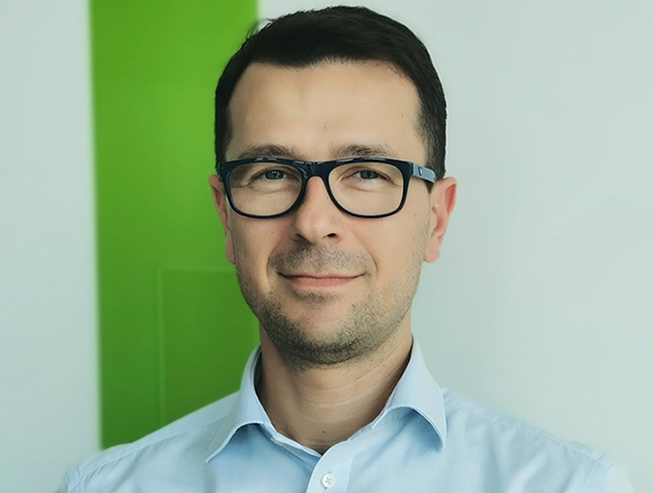“Our customers’ behaviours and expectations are changing. They are looking to simplify their lives, mobile payment is a perfect illustration of this.”
Contactless payments are becoming increasingly popular and are not just about credit card payments. Indeed, even if they are a little less used for the moment, contactless mobile payments (i.e. made with a smartphone) have only recently entered the game. They are developing all over the world with a rather disparate speed of adoption depending on the country. Issues, objectives, challenges and results, Rafal Makowski in charge of the deployment of Apple Pay and Google Pay in Poland tells us everything.
Can you introduce yourself?
I am Rafal Makowski and I am in charge of the department in charge of all credit card activities at BNP Paribas in Poland.

Could you explain to us what these new mobile payment methods offered by BNP Paribas Personal Finance in Poland correspond to?
We have launched two new payment methods: Google Pay and Apple Pay. All our cards were already equipped with contactless technology (NFC). Even before the implementation of mobile payment, we offered our users the possibility of contactless payment. The Polish market is very innovative. In the 1990s, banks began to invest heavily in new technologies because, emerging from communism, the country was lagging behind in this level. We adopted these new technologies quickly and offered innovative solutions such as contactless payment. Today, this method of transaction is very popular in Poland, regardless of age group, since contactless payments represent 70% of global transactions.
Why did you choose to launch these solutions?
Customers were used to using the contactless payment feature of their credit card, so launching Google Pay and Apple Pay was the next logical step. The Polish market, contrary to others markets such as France, is particularly advanced on the adoption of payment via smartphone. So we started investing in new technologies used for mobile payment.
How does it work?
First of all, you must fill your credit card in the Wallet of your phone, through the bank application or directly on the Wallet phone (Apple Wallet for example). Then, instead of paying with your card, you pick up your phone and pay your purchases by placing it on the payment terminal. Simply authorize the payment by unlocking via fingerprint or facial recognition, one more security feature for the users.
What challenges did you take up during the deployment of these solutions?
We started with Google Pay and faced some challenges. These challenges were not necessarily related to the technologies used but rather to the newness, and the fact that it requires learning. We worked with Mastercard to that they could equip themselves with suitable payment terminals. This allowed us to test our reactivity and adaptability.
We then worked on Apple Pay, with more fluidity because we knew the processes to follow, even if there were small differences in deployment. One of the main specificities with Apple is that quite strict rules are given by the apple brand and we have to adapt to them. Indeed, Apple decides in which countries they will deploy Apple Pay. It is not the banks that go to Apple to submit the deployment in a particular country, but Apple decides whether or not to implement its solution.
We were lucky because Apple opened its solution to the Polish market at the end of 2017. Without this, we would not have been able to offer this mobile payment solution to our customers. We were determined to introduce Apple Pay and finally, we were the first Polish bank to be certified by Mastercard and to launch Apple Pay.
Apple users represent only 10% of the users of this new payment method. After the launch of Apple Pay, we noticed that iPhone owners, although fewer in number, were much more open to this type of payment than others. The activity and transaction rate is much higher for this population.
How is the customer experience facilitated?
No need to take out your wallet, take your card, put it in the terminal, dial your pin code, etc. All you have to do is take out your phone and pay like with a contactless card. As an iPhone user, I hardly use my physical card anymore, even if I keep it in case I don't have a battery. Today, in Poland, all payment terminals are equipped with contactless technologies, whether they are bus ticket purchase terminals, in bakeries, or even in car parks.
What were the objectives of this launch?
I would say that mobile payment is linked to the evolution of our societies, to the evolution of consumer behaviour and expectations. By offering contactless mobile payment, BNP Paribas Personal Finance confirms its commitment to support its customers and offer them innovative solutions that make their daily lives easier.
What are the next steps?
In Poland, Apple and Google share 100% of the market so we will not open a new solution like Spain does with Samsung Pay. The next step will be to convince more and more users to use these solutions. This will probably take time because it involves education and the assimilation of these new technologies. However, as a financial institution, it is essential to always offer innovative solutions and we are determined to continue to move in this direction.







![[Podcast On The Way] Thomas Koell – Les Biens en Commun : Sharing to change the way we consume](https://personal-finance.bnpparibas/app/uploads/sites/4/2025/04/les-biens-en-commun_banner-386x386.jpeg?1745317444)

![[Podcast On The Way] Benjamin Martinie – Hourrail: Transforming our travel patterns for a more sustainable future](https://personal-finance.bnpparibas/app/uploads/sites/4/2025/04/moving-train-in-mountains-at-sunset-in-autumn-2024-12-03-22-23-56-utc-386x386.jpg?1745316261)